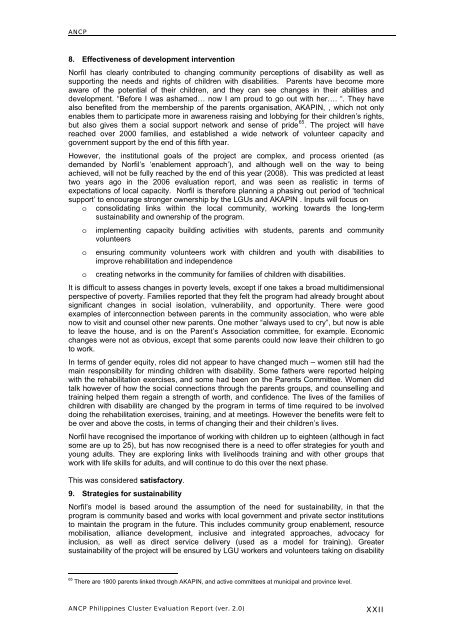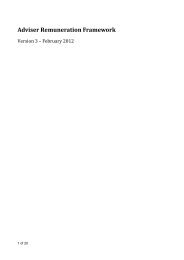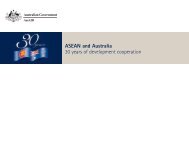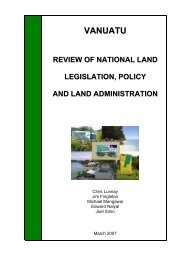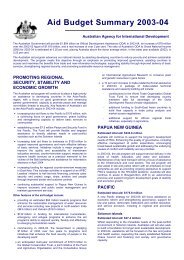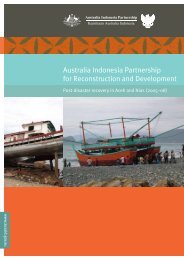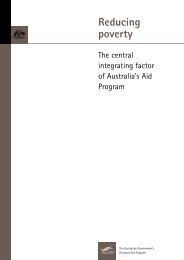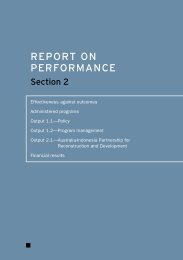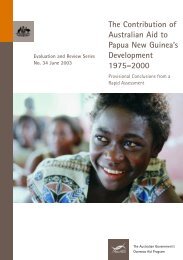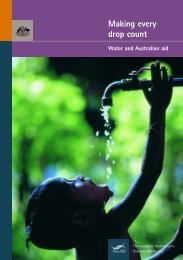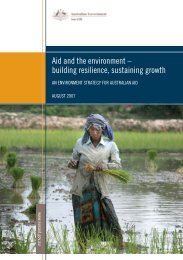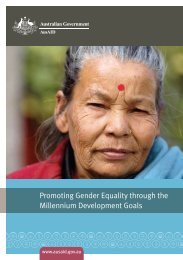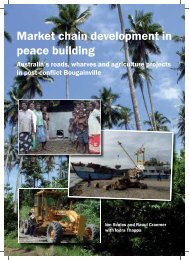ANCP Philippines Cluster Evaluation Report - AusAID
ANCP Philippines Cluster Evaluation Report - AusAID
ANCP Philippines Cluster Evaluation Report - AusAID
You also want an ePaper? Increase the reach of your titles
YUMPU automatically turns print PDFs into web optimized ePapers that Google loves.
<strong>ANCP</strong>8. Effectiveness of development interventionNorfil has clearly contributed to changing community perceptions of disability as well assupporting the needs and rights of children with disabilities. Parents have become moreaware of the potential of their children, and they can see changes in their abilities anddevelopment. “Before I was ashamed… now I am proud to go out with her…. “. They havealso benefited from the membership of the parents organisation, AKAPIN, , which not onlyenables them to participate more in awareness raising and lobbying for their children’s rights,but also gives them a social support network and sense of pride 65 . The project will havereached over 2000 families, and established a wide network of volunteer capacity andgovernment support by the end of this fifth year.However, the institutional goals of the project are complex, and process oriented (asdemanded by Norfil’s ‘enablement approach’), and although well on the way to beingachieved, will not be fully reached by the end of this year (2008). This was predicted at leasttwo years ago in the 2006 evaluation report, and was seen as realistic in terms ofexpectations of local capacity. Norfil is therefore planning a phasing out period of ‘technicalsupport’ to encourage stronger ownership by the LGUs and AKAPIN . Inputs will focus ono consolidating links within the local community, working towards the long-termsustainability and ownership of the program.o implementing capacity building activities with students, parents and communityvolunteerso ensuring community volunteers work with children and youth with disabilities toimprove rehabilitation and independenceocreating networks in the community for families of children with disabilities.It is difficult to assess changes in poverty levels, except if one takes a broad multidimensionalperspective of poverty. Families reported that they felt the program had already brought aboutsignificant changes in social isolation, vulnerability, and opportunity. There were goodexamples of interconnection between parents in the community association, who were ablenow to visit and counsel other new parents. One mother “always used to cry”, but now is ableto leave the house, and is on the Parent’s Association committee, for example. Economicchanges were not as obvious, except that some parents could now leave their children to goto work.In terms of gender equity, roles did not appear to have changed much – women still had themain responsibility for minding children with disability. Some fathers were reported helpingwith the rehabilitation exercises, and some had been on the Parents Committee. Women didtalk however of how the social connections through the parents groups, and counselling andtraining helped them regain a strength of worth, and confidence. The lives of the families ofchildren with disability are changed by the program in terms of time required to be involveddoing the rehabilitation exercises, training, and at meetings. However the benefits were felt tobe over and above the costs, in terms of changing their and their children’s lives.Norfil have recognised the importance of working with children up to eighteen (although in factsome are up to 25), but has now recognised there is a need to offer strategies for youth andyoung adults. They are exploring links with livelihoods training and with other groups thatwork with life skills for adults, and will continue to do this over the next phase.This was considered satisfactory.9. Strategies for sustainabilityNorfil’s model is based around the assumption of the need for sustainability, in that theprogram is community based and works with local government and private sector institutionsto maintain the program in the future. This includes community group enablement, resourcemobilisation, alliance development, inclusive and integrated approaches, advocacy forinclusion, as well as direct service delivery (used as a model for training). Greatersustainability of the project will be ensured by LGU workers and volunteers taking on disability65There are 1800 parents linked through AKAPIN, and active committees at municipal and province level.<strong>ANCP</strong> <strong>Philippines</strong> <strong>Cluster</strong> <strong>Evaluation</strong> <strong>Report</strong> (ver. 2.0)XXII


